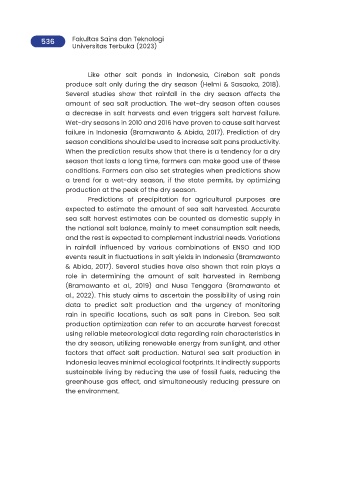Page 575 - Trends in Science and Technology fo Sustainable Living
P. 575
536 Fakultas Sains dan Teknologi
Universitas Terbuka (2023)
Like other salt ponds in Indonesia, Cirebon salt ponds
produce salt only during the dry season (Helmi & Sasaoka, 2018).
Several studies show that rainfall in the dry season affects the
amount of sea salt production. The wet-dry season often causes
a decrease in salt harvests and even triggers salt harvest failure.
Wet-dry seasons in 2010 and 2016 have proven to cause salt harvest
failure in Indonesia (Bramawanto & Abida, 2017). Prediction of dry
season conditions should be used to increase salt pans productivity.
When the prediction results show that there is a tendency for a dry
season that lasts a long time, farmers can make good use of these
conditions. Farmers can also set strategies when predictions show
a trend for a wet-dry season, if the state permits, by optimizing
production at the peak of the dry season.
Predictions of precipitation for agricultural purposes are
expected to estimate the amount of sea salt harvested. Accurate
sea salt harvest estimates can be counted as domestic supply in
the national salt balance, mainly to meet consumption salt needs,
and the rest is expected to complement industrial needs. Variations
in rainfall influenced by various combinations of ENSO and IOD
events result in fluctuations in salt yields in Indonesia (Bramawanto
& Abida, 2017). Several studies have also shown that rain plays a
role in determining the amount of salt harvested in Rembang
(Bramawanto et al., 2019) and Nusa Tenggara (Bramawanto et
al., 2022). This study aims to ascertain the possibility of using rain
data to predict salt production and the urgency of monitoring
rain in specific locations, such as salt pans in Cirebon. Sea salt
production optimization can refer to an accurate harvest forecast
using reliable meteorological data regarding rain characteristics in
the dry season, utilizing renewable energy from sunlight, and other
factors that affect salt production. Natural sea salt production in
Indonesia leaves minimal ecological footprints. It indirectly supports
sustainable living by reducing the use of fossil fuels, reducing the
greenhouse gas effect, and simultaneously reducing pressure on
the environment.

